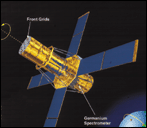

BERKELEY, NASA TEAM UP TO BUILD $72 MILLION SATELLITE
In the first transfer of its kind to a university, the National Aeronautics and Space Administration has given Berkeley total control of a new $72 million satellite scheduled for launch in the year 2000 to study solar flares.
NASA will retain responsibility for the booster and the launch of the satellite, called HESSI (High Energy Solar Spectroscopic Imager), but Berkeley will design and build the instruments, contract out spacecraft construction and even erect a radio antenna in the Berkeley hills to communicate with the satellite.
"We are the first of the Small Explorer science missions to do the whole thing," said project leader Robert P. Lin, Berkeley professor of physics and the new director of Berkeley's Space Sciences Laboratory (SSL).
HESSI will carry a single telescope to take both x-ray and gamma ray snapshots of solar flares -- seen in visible light as sudden, rapid and intense brightenings of the sun's surface near sunspots.
"Solar flares are probably the most powerful explosions in the solar system, the largest releasing as much energy as several billion megatons of TNT," said Lin. "Nobody knows how the sun is able to release this much energy, or why up to half of that is in the form of high-energy particles."
![]()

[Table of Contents] [Berkeley Magazine Home] [UC Berkeley Home Page]
Copyright 1998, Regents of the University of California. All rights reserved.
Comments? E-mail ucbwww@pa.urel.berkeley.edu.